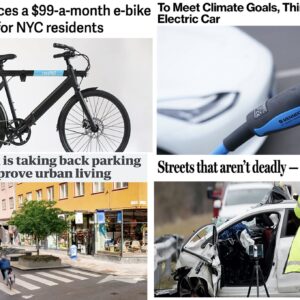In my post last week about changing existing stop sign and yield laws for cyclists, I referred to City of Portland Transportation Planner Stuart Gwin. I’d heard that Stuart had some previous involvement with the Idaho statute that allows bicycles to roll stop signs.
Stuart was formerly the chair of the Citizen Advisory Committe for the Ada County Highway District, which governs several cities in Idaho (including Boise).
He recently shared some information with me about the statute and his involvement as its first test case.
*Please note that Stuart is not speaking in any official capacity and he is not endorsing or advocating for a change in existing Portland traffic laws.
Here’s what he had to say:
“One of the Committee’s first actions was to write a local ordinance that permitted what we called a standing stop at stop signs. This essentially permitted a cyclist to, in Greg Raisman’s (City Traffic Safety guru) words “slow and go”. I don’t recall any community opposition to adoption of the ordinance. On the contrary it was well accepted.
Shortly after it was adopted, I had the opportunity to test it out. I was given a ticket by a Boise policeman, who had not got the word the ordinance defining how a cyclist should treat a stop sign had been revised. I advised him that the law had been changed and he asked me how I knew and I told him – “because I wrote it.” That failed to change his mind and he gave me ticket anyway. I told him I would see him in court and when we met in court the judge threw out the whole thing.
So I can tell you from personal experience it works. The ordinance was subsequently adopted by the state legislature to make it statewide because the experience in Boise had been so positive.”





Hey,
Yea, a rolling stop makes soo much sense.
As a cyclist, I am constantly watching for cars trying to run me over, or that dont even see me.
Stopping at a sign, when ther are no cars for blocks is very silly. Hopefully Oregon will adopt this law SOON!
thanks Jonathon!
Thanks for posting this, JM. I’m clueless when it comes to legislation– what’s the next steps for getting this proposed, written, passed, and, you know, on with our lives?
The BTA is looking at this as possible 2007 legislation — no need to reinvent the wheel.
We work with legislative staff members, attorneys, and policy advocates to get the language right, and will share draft bills with the community for your input this fall.
If you want to help, contact Scott Bricker in our office (scott -at- bta4bikes.org). If we decide not to make this bill a top legislative priority, we can help you get started.
“Thanks for posting this, JM. I’m clueless when it comes to legislation– what’s the next steps for getting this proposed, written, passed, and, you know, on with our lives?”
call your elected officals — that is what they are there for! 🙂
I like the rolling stop idea too.
I’ve been thinking about this a lot lately. First of all I started realizing how much I actually adhere to the Idaho law now.
I had a situation last week where I stopped at an intersection waiting for the light to change. Despite having my bike directly over the sensor the light would not trip. I sat through the light 2x. Finally I used common sense made sure it was clear and yes, ran the red light.
I’ve also noticed when approaching a stop sign (before I’m stopped) drivers often wave me through.
I’m sure you will get a certain amount of drivers who oppose this idea, but my perception is that it may improve the flow of traffic. Not to mention when my Single Speed is loaded down with groceries, I hate losing all the momentum!!
I saw an article in Oregon Cycling magazine by Ray Thomas giving his point of view as well. Sounds like it’s a pretty hot topic right now. I like this proposal and the 3 foot rule.
One last thing:
I lived in Boise for a while and never remember any negative experiences with drivers over this.
Hi Evan,
Thank you for your work with the BTA. Many good legislative efforts have come from the great work that you and your association perform.
However, I must disagree with you discouragement for public citizens having to be a part of your association to enact legislation that they consider vital to considered with your agenda. There are many routes in which we as citizen and cyclist can be apart of our government. The BTA happens to be just one of the many ways in which change can happen.
For example, citizens can join advisory boards for a multitude of local state and government agencies to promote support cycling activities. Also, citizens can take the initiative to work with similar resources the BTA have to draft legislation on their own and coordinate with their representative to submit it as bill.
Please know that I am not attacking you or the BTA in anyway. Just that your reply has what I perceive as an undemocratic undercurrent by advising citizens no to peruse legislative efforts on their own accord or to exclusively rely on lobbyist for legislative change.
Our government does work best when people work together on an issue … though one must always respect an individuals right to peruse their own agenda on their own terms.
Hey, no worries. I didn’t mean to be undemocratic. I meant to say that we’re doing research, looking at the issue, etc. already, so if you want to get involved, let Scott know.
If you want to get your own bill drafted, it might be interesting to see how that would vary from what we’re doing.
The thing to do is to contact your state representative or senator and ask them to get it drafted for you. You send them the rough outline of the idea, and if they like it, they’ll ask Legislative Counsel (the legislator’s lawyers) to draft it into legal language consistent with Oregon law and give it back to the Rep. or Senator, who should then give it to you.
Here’s how to find your rep and senator.
Here’s more on our statewide work
Hi,
It took me two reads of this sentence to get it:
“I told him I would see him in court and when we meant in court the judge through out the whole thing.”
I think it should be:
“I told him I would see him in court and when we met in court the judge threw out the whole thing.”
Confusing through and threw is an easy mistake and happens alot.
otherwise I’m glad to see it, I’d love to see NC adopt a rule like this.
-sv
Hi Seth,
Thanks for the heads up. I’ve edited his quote.
Stuart wrote that in an email to me without expecting it to be published I’m sure…and I didn’t edit it before posting.
And good to hear from someone in North Carolina!
Seth, does it happen alot, or does it happen a lot. I guess it happens to all of us!
Jim,
It does in fact happen a lot. 🙂
I wasn’t chastising anyone for it – just trying to make it easier to follow.
no offense intended.
-sv
Rolling stops are really the way to go. My chances of getting hit by a vehicle are substantially higher when I’m in an intersection. Rolling stops enable me to reduce the time that I’m in the “danger zone”. When done correctly they help car traffic get through quicker as well (by reducing the ammount of time the car has to wait for me to get out of the way).
It is a win-win situation.
I feel the rolling stop method is the way to go. If we could all start consciously doing it, we’d set an example to the non-cycling public that we are not the above-the-law idiots that they perceive cyclists to be. A little dose of civilty goes a long way! I participated in the ride of silence – it gave alot of time to think about our role in the community. People along the route applauded as we went by, though I’m not sure if all of them knew why we were there. It was positive exposure and it was honor to ride in memory for those who are not with us.
Please excuse spelling/semantics errors – blame it on breakfast sticky fingers!
bk
Jessica Roberts sent out this email which is a perfect rebuttel to the ‘bikes don’t stop’ issue.
One of my favorite bloggers taped the cars at a 4-way stop outside his house for an hour, then counted the results to see how many cars actually came to a full stop. The results:
3% full stop
6% stop-ish
91% no stop
Survey lasted 1 hour
276 cars were counted
The whole thing: http://www.cockeyed.com/citizen/stop/stop1.shtml
I think this is relevant to cyclists as we discuss fair and strategic police enforcement and ticketing cyclists who run stop signs. Anyone want to do the same survey in Portland?